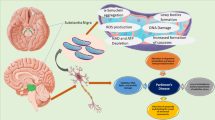Abstract
Objective
Sleep disturbance, which is characterized by excessive daytime sleepiness and sleep attacks, is frequently observed in patients with Parkinson’s disease (PD). Loss of orexin neurons in hypothalamus and the resultant decreased level of orexin in cerebrospinal fluid (CSF) found in narcolepsy patients may also play an essential role in the pathogenesis of sleep disturbance. The present study aimed to investigate the possible changes in the orexin system during PD progression.
Methods
After the establishment of a rat PD model by injecting 6-hydroxydopamine (6-OHDA) into the medial forebrain bundle, the numbers of orexin-A- and tyrosine hydroxylase (TH)-positive neurons, and the levels of orexin-A fibers and orexin-A in CSF were examined by immunohistochemistry and ELISA assay, respectively.
Results
Compared to the TH-containing neurons that exhibited fast degeneration in response to 6-OHDA, orexin-A-containing neurons were less sensitive to 6-OHDA. The number of orexin-A-positive neurons began to decrease at day 21 after operation, and at day 49, it decreased by 30% of the initial level. The orexin-A level in CSF of PD rats did not show any obvious fluctuations compared to the control, and there was no obvious reduction in the density of orexin-A-positive fibers in brain areas such as tuberomammillary nucleus.
Conclusion
These results reveal for the first time the dynamic changes of orexin system during the progression of PD. This may provide valuable information for drug development to reverse the loss of orexin neurons and sleep disturbance in PD patients.
摘要
目的
帕金森病(Parkinson’s disease, PD)患者经常发生以白天睡眠过多和睡眠猝发为特征的睡眠障碍, 其发病机理可能与下丘脑orexin神经元的丢失及其引发的脑脊液中orexin含量降低有关。 本文旨在探讨PD进程中orexin系统的动态变化。
方法
大鼠内侧前脑束中注入6- 羟多巴建立PD模型, 运用免疫组织化学法对orexin-A 阳性和酪氨酸羟化酶(tyrosine hydroxylase, TH)阳性神经元进行染色而后计数, 用ELISA 法对脑脊液中orexin-A 的含量进行检测。
结果
6- 羟多巴能导致中脑TH 神经元的快速凋亡, 而orexin-A 神经元对此变化不敏感。 此外, orexin-A神经元数量在术后21 天时开始下降, 至第49 天时下降幅度达到30%左右。 与对照组相比, 脑脊液中的orexin-A水平并不随PD进程发生明显改变, 并且orexin-A阳性纤维在一些睡眠调节相关脑区(如结节乳头体核)内也无明显的数量变化。
结论
以上结果揭示了orexin 系统随PD进程的动态变化情况, 对于以逆转orexin 神经元丢失和缓解PD病人睡眠障碍为目的的药物研发具有一定的指导意义。
Similar content being viewed by others
References
Fronczek R, Baumann CR, Lammers GJ, Bassetti CL, Overeem S. Hypocretin/orexin disturbances in neurological disorders. Sleep Med Rev 2009, 13: 9–22.
Lin L, Faraco J, Li R, Kadotani H, Rogers W, Lin X, et al. The sleep disorder canine narcolepsy is caused by a mutation in the hypocretin (orexin) receptor 2 gene. Cell 1999, 98: 365–376.
Chemelli RM, Willie JT, Sinton CM, Elmquist JK, Scammell T, Lee C, et al. Narcolepsy in orexin knockout mice: molecular genetics of sleep regulation. Cell 1999, 98: 437–451.
Nishino S, Ripley B, Overeem S, Lammers GJ, Mignot E. Hypocretin (orexin) deficiency in human narcolepsy. Lancet 2000, 355: 39–40.
Hobson DE, Lang AE, Martin WR, Razmy A, Rivest J, Fleming J. Excessive daytime sleepiness and sudden-onset sleep in Parkinson disease: a survey by the Canadian Movement Disorders Group. JAMA 2002, 287: 455–463.
Arnulf I, Bonnet AM, Damier P, Bejjani BP, Seilhean D, Derenne JP, et al. Hallucinations, REM sleep, and Parkinson’s disease: a medical hypothesis. Neurology 2000, 55: 281–288.
Drouot X, Moutereau S, Nguyen JP, Lefaucheur JP, Créange A, Remy P, et al. Low levels of ventricular CSF orexin/hypocretin in advanced PD. Neurology 2003, 61: 540–543.
Fronczek R, Overeem S, Lee SY, Hegeman IM, van Pelt J, van Duinen SG, et al. Hypocretin (orexin) loss in Parkinson’s disease. Brain 2007, 130: 1577–1585.
Thannickal TC, Lai YY, Siegel JM. Hypocretin (orexin) cell loss in Parkinson’s disease. Brain 2007, 130: 1586–1595.
Asai H, Hirano M, Furiya Y, Udaka F, Morikawa M, Kanbayashi T, et al. Cerebrospinal fluid-orexin levels and sleep attacks in four patients with Parkinson’s disease. Clin Neurol Neurosurg 2009, 111: 341–344.
Poceta JS, Parsons L, Engelland S, Kripke DF. Circadian rhythm of CSF monoamines and hypocretin-1 in restless legs syndrome and Parkinson’s disease. Sleep Med 2009, 10: 129–133.
Mandel RJ, Spratt SK, Snyder RO, Leff SE. Midbrain injection of recombinant adeno-associated virus encoding rat glial cell linederived neurotrophic factor protects nigral neurons in a progressive 6-hydroxydopamine-induced degeneration model of Parkinson’s disease in rats. Proc Natl Acad Sci U S A 1997, 94: 14083–14088.
Chen CT, Dun SL, Kwok EH, Dun NJ, Chang JK. Orexin A-like immunoreactivity in the rat brain. Neurosci Lett 1999, 260: 161–164.
Marinova-Mutafchieva L, Sadeghian M, Broom L, Davis JB, Medhurst AD, Dexter DT. Relationship between microglial activation and dopaminergic neuronal loss in the substantia nigra: a time course study in a 6-hydroxydopamine model of Parkinson’s disease. J Neurochem 2009, 110: 966–975.
Gerashchenko D, Murillo-Rodriguez E, Lin L, Xu M, Hallett L, Nishino S, et al. Relationship between CSF hypocretin levels and hypocretin neuronal loss. Exp Neurol 2003, 184: 1010–1016.
Jeon BS, Jackson-Lewis V, Burke RE. 6-Hydroxydopamine lesion of the rat substantia nigra: time course and morphology of cell death. Neurodegeneration 1995, 4: 131–137.
Author information
Authors and Affiliations
Corresponding author
Additional information
An erratum to this article is available at http://dx.doi.org/10.1007/s12264-016-0043-8.
Rights and permissions
About this article
Cite this article
Long-Biao, C., Bo-Wei, L., Xiao-Hang, J. et al. Progressive changes of orexin system in a rat model of 6-hydroxydopamineinduced Parkinson’s disease. Neurosci. Bull. 26, 381–387 (2010). https://doi.org/10.1007/s12264-010-0410-9
Received:
Accepted:
Published:
Issue Date:
DOI: https://doi.org/10.1007/s12264-010-0410-9




